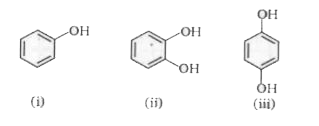Out of internal energy (I), boiling point (II), pH (III) and E.M.F. of the cell (IV) intensive properties are :
I, II
II, III, IV
I, III, IV
All of these
The correct Answer is:B
To determine which of the given properties are intensive, we need to understand the definitions of intensive and extensive properties.
Step 1: Define Intensive and Extensive Properties
- Intensive properties are those that do not depend on the amount of substance present. Examples include boiling point, density, and pH.
- Extensive properties depend on the amount of substance present. Examples include mass, volume, and internal energy.
Step 2: Analyze Each Property
1. Internal Energy (I):
- Internal energy is the total energy contained within a system, which includes kinetic and potential energy. It depends on the amount of substance present.
- Conclusion: Internal energy is an extensive property.
2. Boiling Point (II):
- The boiling point of a substance is the temperature at which it changes from liquid to gas. It remains constant regardless of the amount of substance (e.g., 100°C for water).
- Conclusion: Boiling point is an intensive property.
3. pH (III):
- pH is a measure of the acidity or basicity of a solution. It remains the same regardless of the volume of the solution (e.g., the pH of a 0.1 M HCl solution is the same whether you take 10 mL or 20 mL).
- Conclusion: pH is an intensive property.
4. E.M.F. of the Cell (IV):
- The electromotive force (E.M.F.) of a cell is the voltage generated by the cell. It does not depend on the amount of reactants present in the cell.
- Conclusion: E.M.F. is an intensive property.
Step 3: Summarize the Findings
- From the analysis:
- Internal Energy (I) - Extensive Property
- Boiling Point (II) - Intensive Property
- pH (III) - Intensive Property
- E.M.F. of the Cell (IV) - Intensive Property
Final Answer: The intensive properties among the given options are Boiling Point (II), pH (III), and E.M.F. of the Cell (IV).
- Intensive properties are those that do not depend on the amount of substance present. Examples include boiling point, density, and pH.
- Extensive properties depend on the amount of substance present. Examples include mass, volume, and internal energy.
1. Internal Energy (I):
- Internal energy is the total energy contained within a system, which includes kinetic and potential energy. It depends on the amount of substance present.
- Conclusion: Internal energy is an extensive property.
- The boiling point of a substance is the temperature at which it changes from liquid to gas. It remains constant regardless of the amount of substance (e.g., 100°C for water).
- Conclusion: Boiling point is an intensive property.
- pH is a measure of the acidity or basicity of a solution. It remains the same regardless of the volume of the solution (e.g., the pH of a 0.1 M HCl solution is the same whether you take 10 mL or 20 mL).
- Conclusion: pH is an intensive property.
- The electromotive force (E.M.F.) of a cell is the voltage generated by the cell. It does not depend on the amount of reactants present in the cell.
- Conclusion: E.M.F. is an intensive property.
- From the analysis:
- Internal Energy (I) - Extensive Property
- Boiling Point (II) - Intensive Property
- pH (III) - Intensive Property
- E.M.F. of the Cell (IV) - Intensive Property
Topper's Solved these Questions
Similar Questions
Out of molar entropy (I), specific volume (II), heat capacity (III), volume (IV), extensive properties are :
View SolutionWhich of the following properties of halogens increase with increasing atomic number?
(I) Ionization energy
(II) Ionic radius
(III) Bond energy of the X2 molecule
(IV) Enthalpy of vaporisationView Solution
Knowledge Check
- Question 1 - Select One
Arrange the following in decreasing order of their boiling points:
(I) n-Butane
(II) 2-Methylbutane,
(III) n-Pentane
(IV) 2,2-DimethylpropaneAIgtIIgtIIIgtIVBIIgtIIIgtIVgtICIVgtIIIgtIIgtIDIIIgtIIgtIVgtI - Question 2 - Select One
Among i-iii

the boiling point follows the orderA(ii)<(i)<(iii)B(iii)<(ii)<(i)C(i)<(ii)<(iii)D(ii)<(iii)<(i)
If the e.m.f of a galvanic cell is negative, it implies that:
View SolutionArrange the following in order of decreasing boiling point (i) Propan-1-ol (ii) propanal (ill) propanone (iv) Propane.
View SolutionArrange the following in order of decreasing boiling point (i) Propan-1-ol (ii) propanal (ill) propanone (iv) Propane.
View SolutionArrange the following in order of decreasing boiling point (i) Propan-1-ol (ii) propanal (ill) propanone (iv) Propane.
View SolutionA dry cell of emf 1.5V and internal resistance 0.10Ω is connected across a resistor in series with a very low resistance ammeter. When the circuit is switched on , the ammeter reading settles to a steady value of 2.0A.
(i) What is the steady rate of chemical energy consumption of the cell ?
(ii) What is the steady rate of energy dissipation inside the cell ?
(ii) What is the steady rate of energy dissipation inside the resistor ?
(iv) What is the steady power out put of the source?View SolutionWhich of the following statements are correct regarding the organelle, lysosome ?
I. It contains enzymes mostly active in acidic pH.
II. It is known as the suicidal bag .
III. These organelles are directly derived from the endoplasmic reticulum .
IV. It contains water , sap, excretory product and other materials not useful for the cell.
(a) I , II ,III and IV
(b) I and II only
(c) II and III only
(d) I, II and IV onlyView Solution

